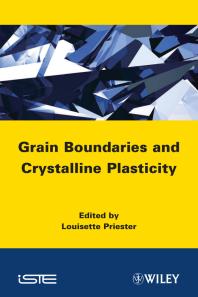书目详情:
CoverGrain Boundaries and Crystalline PlasticityTitle PageCopyright PageTable of ContentsPrefaceChapter 1. Grain Boundary Structures and Defects1.1. Equilibrium structure of grain boundaries1.1.1. Geometric description and elements of bicrystallography1.1.2. Grain boundary structure in terms of intrinsic dislocations1.1.3. Grain boundary atomic structure – structural unit model1.1.4. Energetic atomic description1.2. Crystalline defects of grain boundaries1.2.1. Point defects – intergranular segregation1.2.2. Linear defects: extrinsic dislocations1.2.3. Volume defects – grain boundary precipitation1.3. Conclusion1.4. BibliographyChapter 2. Elementary Grain Boundary Deformation Mechanisms2.1. Dislocation in close proximity to a grain boundary2.2. Elastic interaction between dislocations and grain boundaries: image force2.3. Short range or core) interaction between dislocations and grain boundaries2.3.1. Geometric and energetic criteria for slip transmission2.3.2. Elementary mechanisms of dislocations at grain boundaries2.3.3. Atomic scale simulations of interaction mechanisms between dislocations and grain boundaries2.3.4. Experimental observations of interaction mechanisms2.3.5. Elastic stress fields associated with extrinsic dislocations2.4. Relaxation of stress fields associated with extrinsic dislocations2.4.1. Relaxation processes in a grain boundary2.4.2. Evolution of stress fields with relaxation time2.4.3. Experimental studies of grain boundary relaxation phenomena2.4.4. Conclusion2.5. Relationships between elementary interface mechanisms and mechanical behaviors of materials2.6. BibliographyChapter 3. Grain Boundaries in Cold Deformation3.1. Introduction3.2. Plastic compatibility and incompatibility of deformation at grain boundaries3.2.1. General points3.2.2. Calculation of incompatibilities in a bicrystal3.3. Internal stresses in polycrystal grains3.3.1. Notions of crystalline plasticity, single crystal behavior for use in polycrystalline models3.3.2. Internal stresses in polycrystals3.3.3. Stress relaxation mechanisms3.4. Modeling local mechanical fields using the finite element method FEM)3.4.1. Aggregates3.4.2. From single crystal to polycrystal using finite transformations3.4.3. Identification of the constitutive and hardening law parameters3.4.4. Examples of local mechanical fields proposed by the polycrystalline models3.5. Hall-Petch’s law, geometrically necessary dislocations3.5.1. Definition3.5.2. Modeling the grain size effect in polycrystals, comparison with experiments3.6. Sub-grain boundaries and grain boundaries in deformation and recrystallization3.6.1. Deformation sub-boundaries and grain boundaries3.6.2. Recrystallization sub-grain boundaries3.7. Conclusion3.8. BibliographyChapter 4. Creep and High Temperature Plasticity: Grain Boundary Dynamics4.1. Introduction4.2. Grain boundaries and grain growth4.2.1. Kinetics and grain growth law4.2.2. Grain boundary segregation and precipitation – influence on the boundary mobility4.3. Grain boundaries and creep: mechanisms and phenomenological laws4.3.1. Grain boundary mechanisms4.3.2. Creep models and kinetics4.3.3. Constitutive creep laws and deformation mechanism maps4.3.4. Limit of the models, grain boundaries chemistry and creep4.4. Grain boundaries and superplasticity4.4.1. Phenomenology and microstructural mechanisms4.4.2. The different models4.4.3. Grain growth and superplastic deformation4.5. Prospects: creep of nanograined materials4.6. BibliographyChapter 5. Intergranular Fatigue5.1. Introduction5.2. Low temperature intergranular fatigue5.2.1. Several scales to be considered to explain intergranular fatigue5.2.2. Study of ᾶ iron and of other BCC metals and metallic alloys5.2.3. Intergranular fatigue of FCC metals and metallic alloys5.3. High temperature fatigue5.3.1. General information5.3.2. Austenitic stainless steels5.3.3. Nickel-based superalloys5.4. Conclusion5.5. Acknowledgements5.6. BibliographyChapter 6. Intergranular Segregation and Crystalline Material Fracture6.1. Grain boundaries and fracture6.1.1. Fracture parameters – different types of fracture6.1.2. Intergranular fracture6.2. Intergranular segregation6.2.1. The origin of segregation6.2.2. Thermodynamics of equilibrium segregation – existing models6.2.3. General characteristics of intergranular equilibrium segregation6.2.4. Non-equilibrium segregation6.2.5. Heterogeneity of the intergranular segregation: effects of the grain boundary structure6.3. Segregation and intergranular fracture6.3.1. Intergranular embrittlement mechanisms6.3.2. From embrittling segregations to strengthening segregations6.4. Intergranular fracture induced by liquid metals6.4.1. Phenomena occurring under contact with a liquid metal6.4.2. Liquid metal embrittlement6.4.3. Intergranular penetration6.4.4. Intergranular diffusion in the case of the Cu-Bi system6.4.5. Intergranular wetting in the case of the Ni-Bi system6.4.6. Intergranular penetration mechanism6.4.7. Case of the Al-Ga system6.4.8. Conclusion6.5. General conclusion6.6. BibliographyAPPENDICESAppendix 1. Bicrystallography and Topological Characterization of Interfacial DefectsAppendix 2. Appendices of Chapter 3A2.1. NotationsA2.2. Infinitesimal deformationsA2.2.1. Plastic deformation and rotationA2.3. Finished transformationsA2.3.1. GeometryA2.3.2. KinematicsA2.4. Incompatibility in finished transformationsA2.5. Calculation of the geometrically necessary dislocation densitiesList of AuthorsIndex
评论:








